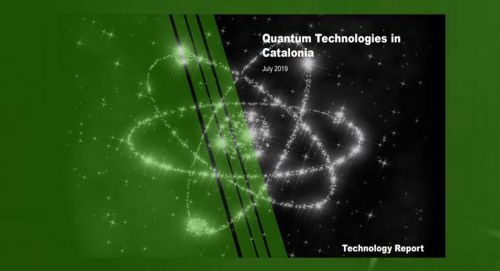
29/10/2019
The ICN2 research center is involved in the quantum revolution
The ICN2 research center is involved in the quantum revolution
We are living through a quantum revolution based on technologies that use the very little intuitive behavior of matter and light and its interactions at the scale of atoms and photons. Such a behavior is well described by quantum mechanics, a branch a physics born at the beginning of the 20th century.
Two fields are specially impacted by this revolution: communication and computation. Regarding the first one, quantum technology already allows fully secure communications. In computation, things are not so advanced but the uniqueness of the individual behaviors of atoms can allow new ways of computing and thus offer phenomenal powers of calculation, even impossible in a classical way.
In this context, the Catalan government agency for business competitiveness ACCIÓ recently issued a report jointly written with the Institute of Photonic Sciences (ICFO) on the potential of Catalonia in this sector. Among the 6 public research centers pointed out in this document, 3 are on the UAB campus, the key partner of the Barcelona Synchrotron Park: the National Center for Microelectronics (CNM), the Institute of High Energy Physics (IFAE) and the Catalan Institute of Nanoscience and Nanotechnology (ICN2).
Regarding ICN2, the research center recently announced that it has expanded its collaboration with the global network of Microsoft Quantum Labs in furtherance of the goal of developing a scalable quantum computer. The ICN2 laboratories will provide atomic-scale measurements, analysis, and modeling of new materials.
The ICN2 Advanced Electron Nanoscopy Group, led by ICREA Prof. Jordi Arbiol, will provide its expertise in electron microscopy and related spectroscopies to perform measurements and analysis of the complex structure and physical properties of a new kind of nanowires that could be used in quantum computers.
Two fields are specially impacted by this revolution: communication and computation. Regarding the first one, quantum technology already allows fully secure communications. In computation, things are not so advanced but the uniqueness of the individual behaviors of atoms can allow new ways of computing and thus offer phenomenal powers of calculation, even impossible in a classical way.
In this context, the Catalan government agency for business competitiveness ACCIÓ recently issued a report jointly written with the Institute of Photonic Sciences (ICFO) on the potential of Catalonia in this sector. Among the 6 public research centers pointed out in this document, 3 are on the UAB campus, the key partner of the Barcelona Synchrotron Park: the National Center for Microelectronics (CNM), the Institute of High Energy Physics (IFAE) and the Catalan Institute of Nanoscience and Nanotechnology (ICN2).
Regarding ICN2, the research center recently announced that it has expanded its collaboration with the global network of Microsoft Quantum Labs in furtherance of the goal of developing a scalable quantum computer. The ICN2 laboratories will provide atomic-scale measurements, analysis, and modeling of new materials.
The ICN2 Advanced Electron Nanoscopy Group, led by ICREA Prof. Jordi Arbiol, will provide its expertise in electron microscopy and related spectroscopies to perform measurements and analysis of the complex structure and physical properties of a new kind of nanowires that could be used in quantum computers.
More news
28/01/2021
Institutional visit to the Elena Renewable Gas Plant in Parc de l'Alba
12/01/2021
2021: the Alba synchrotron begins its mutation
30/12/2020
The Park has a new Urban Development Master Plan
29/11/2020
The director of Parc de l'Alba, Pere Solà, academic director of the new Postgraduate Course in Urban Planning and Health at the UPC School
18/11/2020
Catalan minister Ramon Tremosa visits the ALBA synchrotron and announces the creation of a public-private investment fund to improve knowledge transfer
03/11/2020
Catalonia, at the forefront of Europe in life sciences and health; the Alba synchrotron contributes to this leadership









